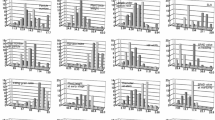Summary
Despite the concerns for genetic vulnerability that were raised in the 1970s, the field uniformity of the Japonica rice (Oryza sativa L.) region in Taiwan has increased since 1980 with over 82% of the cultivated areas being covered by as few as three varieties and over half of this hectarage by a single variety. Japanese plant introductions are the major ancestral contributors of genetic constituents for varieties released in Taiwan. The main constitution of the genetic base present in the field has changed little since 1971. Six common ancestors comprised 60%, 55%, 78%, and 77% of the genetic constituents present in the field in 1971, 1976, 1981, and 1986, respectively. These estimates revealed that at least 55% of the genes utilized in the last 15 years came from the same sources. Recent efforts in introducing new germ plasm sources to variety development should continue to alleviate the possible crop loss due to continuous monoculture.
Similar content being viewed by others
References
Council of Agriculture, Department of Agriculture & Forestry, Food & Fertilizer Technology Center (1987) Rice varieties in Taiwan 1930–1987 (in Chinese). Council of Agriculture, Executive Yuan
Cox TS, Kiang YT, Gorman MB, Rodgers DM (1985) Relationships between coefficient of parentage and genetic similarity indices in the soybean. Crop Sci 25:529–532
Cox TS, Murphy JP, Rodgers DM (1986) Changes in genetic diversity in the red winter wheat regions of the United States. Proc Natl Acad Sci USA 83:5583–5586
Delannay X, Rodgers DM, Palmer RG (1983) Relative genetic contributions among ancestral lines to North American soybean cultivars. Crop Sci 23:944–949
Dilday RH (1990) Contribution on ancestral lines in the development of new cultivars of rice. Crop Sci 30:905–911
Kempthorne O (1969) An introduction to genetic statistics. Iowa State University Press, Ames, Iowa
Knauft DA, Gorbet DW (1989) Genetic diversity among peanut cultivars. Crop Sci 29:1417–1422
Murphy JP, Cox TS, Rodgers DM (1986) Cluster analysis of red winter wheat cultivars based upon coefficients-of-parentage. Crop Sci 26:672–676
Souza E, Sorrells ME (1989) Pedigree analysis of North American oat cultivars released from 1951 to 1985. Crop Sci 29:595–601
St Martin SK (1982) Effective population size for the soybean improvement program in maturity groups 00 to IV. Crop Sci 22:151–152
Author information
Authors and Affiliations
Additional information
Communicated by A. R. Hallauer
Research supported by National Science Council (NSC 78-0211-B005-14)
Rights and permissions
About this article
Cite this article
Lin, M.S. Field uniformity of the Japonica rice region of Taiwan as estimated by relative genetic contribution. Theoret. Appl. Genetics 83, 115–118 (1991). https://doi.org/10.1007/BF00229233
Received:
Accepted:
Issue Date:
DOI: https://doi.org/10.1007/BF00229233




